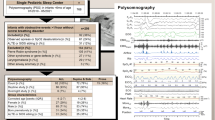Summary
Question of the study
The study's purpose was to compare asymptomatic preterm twins with matched singleton preterms concerning central apnoea and periodic breathing recorded by cardiorespiratory polygraphy during sleep in order to assess whether preterm twins have more central apnoea and periodic breathing dependent on birthweight than singletons.
Patients and methods
Fourteen preterm twins were matched with singleton preterms. All infants underwent 12-h nocturnal cardiorespiratory polygraphy. Central apnoeas, periodic breathing, desaturations and body movements were recorded. Statistical comparison of the first (Twin I) and second (Twin II) twins with singletons was performed.
Results
There was no difference between twins and singletons in the frequency of central apnoeas, episodes of periodic breathing or body movements. The incidence of desaturations in both twin groups was slightly higher than in the singleton group. Increasing birthweight correlated significantly with decreasing frequency of central apnoeas in Twin II (r=−0.7; P<0.05) and Singleton (r=−0.8; P<0.05). In Twin I the correlation was no significant (r=−0.4; P<0.2).
Conclusion
We conclude that central apnoeas in preterm infants are significantly dependent on birthweight and development in second twins and in singletons. Because preterm twins are at higher risk of low and very low birthweight, they subsequently are at higher risk of the occurrence of central apnoeas.
Zusammenfassung
Fragestellung
Das Ziel der Studie ist ein Vergleich zwischen frühgeborenen Zwillingen und frühgeborenen Einzelkindern, um abzuschätzen, ob bei frühgeborenen Zwillingen vermehrt zentrale Apnoen und periodische Atmung in Abhängigkeit zum Geburtsgewicht auftreten als bei frühgeborenen Einzelkindern.
Patienten und Methodik
14 frühgeborene Zwillinge wurden mit frühgeborenen Einzelkindern verglichen. Alle Frühgeborenen wurden für 12 Stunden nachts kardiorespiratorisch untersucht. Zentrale Apnoen, periodische Atmung, Sauerstoffentsättigung und Körperbewegungen wurden aufgezeichnet. Statistisch wurden die erstgeborenen mit den zweitgeborenen Zwillingen sowie mit den frühgeborenen Einzelkindern verglichen.
Ergebnisse
Es gab keinen Unterschied zwischen den Zwillingen und Einzelkindern in der Anzahl zentraler Apnoen, dem Anteil an periodischer Atmung oder Körperbewegungen. Die Anzahl der Sauerstoffsättigungsabfälle war bei den Zwillingen gering höher als bei den Einzelkindern. Höheres Geburtsgewicht korrelierte signifikant mit einem geringeren Anteil zentraler Apnoen bei den zweitgeborenen Zwillingen (r=−0.7; P<0.05) und frühgeborenen Einzelkindern (r=−0.8; P<0.05), bei den erstgeborenen Zwillingen zeigte sich dahingehend keine Signifikanz (r=−0.4; P<0.2).
Schlussfolgerung
Zentrale Apnoen bei Frühgeborenen sind signifikant vom Geburtsgewicht bzw. der Entwicklung abhängig. Da frühgeborene Zwillinge ein höheres Risiko für ein geringeres Geburtsgewicht haben, haben sie ggf. ein höheres Risiko für zentrale Apnoen.
Similar content being viewed by others
References
Albani M, Bentele KHP, Budde C, Schulte FJ: Infant sleep apnea profile: preterm vs. term infants. Eur J Pediatr 143: 261–268, 1985.
Buekens P, Wilcox A: Why do small twins have a lower mortality rate than small singletons? Am J Obstet Gynecol 168: 937–941, 1993.
Cheung VY, Bocking AD, Dasilva OP: Preterm discordant twins: what birth weight difference is significant? Am J Obstet Gynecol 172(3): 955–959, 1995.
Curzi-Dascalova L, Christova-Guéorguiéva E: Respiratory pauses in normal prematurely born infants. A comparison with full-term newborns. Biol Neonate 44: 325–332, 1983.
Curzi-Dascalova L, Christova-Guéorguiéva L, Lebrun F, Firtion G: Respiratory pauses in very low risk prematurely born infants reaching normal term. A comparison to full-term newborns. Neuropediatrics 15: 13–17, 1984.
Fliegner JR, Eggers TR: The relationship between gestational age and birth-weight in twin pregnancy. Aust N Z J Obstet Gynaecol 24(3): 192–197, 1984.
Fraser D, Picard R, Picard E, Leiberman JR: Birth weight discordance, intrauterine growth retardation and perinatal outcomes in twins. J Reprod Med 39(7): 504–508, 1994.
Friedman AF, Schiff E, Kao L, Kuint J, Sibai BM: Do twins mature earlier than singletons? Results from a matched cohort study. Am J Obstet Gynecol 176: 1193–1199, 1997.
Glotzbach SF, Baldwin RB, Lederer NE, Tansey PA, Ariagno RL: Periodic breathing in preterm infants: incidence and characteristics. Pediatrics 84: 785–792, 1989.
Harrison H: Apnea of prematurity: theophylline v. caffeine. Alaska Med 173–176, 1992.
Lee D, Caces R, Kwiatkowski K, Cates D, Rigatto H: A developmental study on types and frequency distribution of short apneas (3 to 15 seconds) in term and preterm infants. Pediatr Res 22: 344–349, 1987.
Luke B, Witter FR, Abbey H, Feng T, Namnoum AB, Paige DM, Johnson TR: Gestational age-specific birthweights of twins versus singletons. Acta Genet Med Gemellol (Roma) 40(1): 69–76, 1991.
McCulloch KM, Kelly DH: Prospective pneumogram recordings in preterm infants with and without clinical apnea and bradycardia. Pediatr Pulmonol 8(1): 33–39, 1990.
Plank K, Mikulaj V, Stencl J, Drobná H, Klesken P: Prevention and treatment of prematurity in twin gestation. J Perinat Med 21: 309–313, 1993.
Poets CF, Stebbens VA, Samuels MP, Southall DP: Oxygen saturation and breathing patterns in children. Pediatrics 92: 686–690, 1993.
Powers WF, Kiely JL: The risks confronting twins: a national perspective. Am J Obstet Gynecol 170: 456–461, 1994.
Schechtman VL, Harper RM, Wilson AJ, Southall DP: Sleep state organization in normal infants and victims of sudden infant death syndrome. Pediatrics 89: 865–870, 1992.
Thorpy MJ (ed): The international classification of sleep disorders. Diagnostic and coding manual. Am Sleep Disorders Ass. Allen Press, Lawrence KS, 1992.
Upton CJ, Milner AD, Stokes GM: Apnoea, bradycardia, and oxygen saturation in preterm infants. Arch Dis Child 66: 381–385, 1991.
Author information
Authors and Affiliations
Corresponding author
Rights and permissions
About this article
Cite this article
Hoch, B., Bernhard, M. Central apnoea and periodic breathing in preterm twins compared with preterm singletons. Somnologie 8, 20–24 (2004). https://doi.org/10.1111/j.1439-054X.2003.00011.x
Received:
Accepted:
Issue Date:
DOI: https://doi.org/10.1111/j.1439-054X.2003.00011.x




